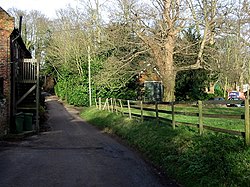Knowlton, Kent
| Knowlton | |
| Kent | |
|---|---|
 Road on the Knowlton Estate | |
| Location | |
| Grid reference: | TR280534 |
| Location: | 51°14’6"N, 1°16’30"E |
| Data | |
| Post town: | Canterbury |
| Postcode: | CT3 |
| Local Government | |
| Council: | Dover |
Knowlton is a tiny village in Kent, found along a dead-end lane east of the village of Chillenden, halfway between Canterbury and the coast at Deal. It is about 10 miles north of Dover. Knowlton Hall, set in 200 acres of parkland, is here.
It was once served (1916-1948) by a halt on the East Kent Light Railway, one of Colonel Stephen's lines, which ran between Sheperdswell & Wingham.
Church
The Church of St Clement is now a redundant church and in the care of the Churches Conservation Trust.
St Clement is an interesting mediæval church which contains many fine monuments. It is open daily for visitors and remains in occasional use. The Rector of Knowlton lived at Chillenden, a picturesque village about a mile west of Knowlton, and parishioners must walk across to Chillenden for worship.
The Great War and the Bravest village
Knowlton is a Thankful Village, one of the few in the land which sent its men to fight in the Great War, the First World War, and received them all back alive. It is the only such village in Kent.
In 1914 the Weekly Dispatch launched a competition to find the "Bravest Village in the United Kingdom". The "Bravest Village" was defined as the one from which the largest proportion of its men volunteered to serve in the armed forces before 28 February 1915. Nearly 400 villages competed. The prize was a cross of Aberdeen granite about 17 feet high, with the figures of a soldier, a nurse, a casualty, and Victory at the top of the column, and a Roll of Honour on the plinth. The then Attorney General, Lord Birkenhead, judged the competition and decided that Knowlton should be the winner. According to the inscription on the plinth, 12 men of Knowlton enlisted from a total population of 39. The prize was awarded and the cross was unveiled on 1 September 1919 by Lord Stanhope. It stands to bear witness yet at the side of Sandwich Road.
The unveiling is described in The Times of 8 September 1919 under the heading "Bravest Village. Memorial Unveiled at Knowlton, Kent". In this article, Knowlton is described as a "beautiful village", but also as "an old but diminutive hamlet". The inscription reads:
ONE CROWDED HOUR OF GLORIOUS LIFE IS WORTH AN AGE WITHOUT A NAME: THIS CROSS WAS ERECTED IN HONOUR OF THOSE TWELVE MEN OF KNOWLTON WHO OUT OF A TOTAL POPULATION OF 39 ENLISTED PRIOR TO MARCH 1915 AND BY THEIR PATRIOTIC ACTION WON THE WEEKLY DISPATCH "BRAVEST VILLAGE" COMPETITION.
THOSE WHO SERVED WITH HIS MAJESTY'S FORCES IN THE GREAT WAR
The village
Knowlton has been described either as a village or a hamlet. It description by the ‘’Weekly Dispatch’’ “beautiful” and “old but diminutive” as are as true today as then.
The description of "hamlet" would be more accurate today than "village", given its size and now the church stands empty. Knowlton was an estate dependent on a manor house, Knowlton Court, with a farm, a lodge (built in 1912 by Lutyens), a dower house, two cottages, and the church, staill dstanding iof not active for regular worship.
